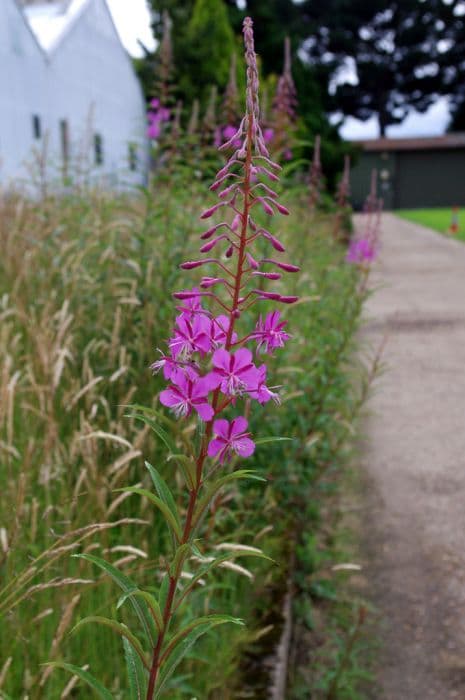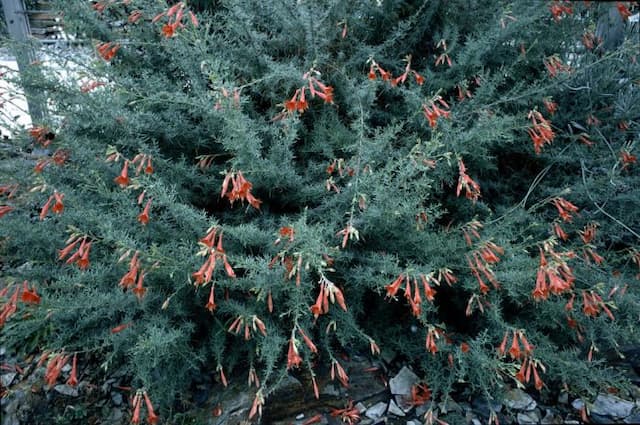Fuchsia Fuchsia 'Tom Thumb'

ABOUT
Fuchsia 'Tom Thumb' is characterized by its gracefully drooping flowers, which are a striking two-tone display of purple and pink. The blooms hang from the branches resembling dainty earrings, with the outer petals often a deep pink, elegantly curving back to reveal a purple inner skirt, accompanied by long, slender, and often pink to purple-colored stamens. The foliage of the plant is bushy with small, oval-shaped leaves that are deep green in color, which provides a lush backdrop to the vivid floral display. This combination of the dark green foliage and vivid flowers makes Fuchsia 'Tom Thumb' a particularly attractive plant for gardeners seeking a splash of color in their garden.
About this plant
 Names
NamesFamily
Onagraceae
Synonyms
Lady's Eardrops, Fairy Bells, Hummingbird Fuchsia
Common names
Fuchsia 'Tom Thumb'.
 Toxicity
ToxicityTo humans
Fuchsia 'Tom Thumb' is considered non-toxic to humans. Generally, this plant does not cause any harmful effects if touched or ingested.
To pets
Fuchsia 'Tom Thumb', more commonly known just as Fuchsia, is also considered non-toxic to pets. It should not cause any serious symptoms of poisoning if pets happen to ingest parts of the plant. However, gastrointestinal upset is a possibility with the ingestion of any non-food item by pets.
 Characteristics
CharacteristicsLife cycle
Perennials
Foliage type
Deciduous
Color of leaves
Green
Flower color
Mixed
Height
1-2 feet (30-60 cm)
Spread
1-2 feet (30-60 cm)
Plant type
Shrub
Hardiness zones
9
Native area
Central and South America
Benefits
 General Benefits
General Benefits- Ornamental Appeal: The Fuchsia 'Tom Thumb' is prized for its attractive, pendant-shaped flowers with a unique two-tone color palette of purple and pink.
- Compact Size: It is a dwarf variety, making it ideal for small gardens, patios, or balconies where space is limited.
- Container Friendly: This plant does well in pots and hanging baskets, adding versatility to its placement and allowing it to be moved to suit seasonal conditions.
- Attracts Pollinators: The flowers provide a valuable nectar source for hummingbirds and butterflies, promoting biodiversity in the garden.
- Long Blooming: The Fuchsia 'Tom Thumb' offers a long flowering season, often from late spring to early fall, providing extended visual interest.
- Shade Tolerance: While it enjoys some sun, this plant can also perform well in partially shaded areas, offering flexibility in garden design.
- Easy Pruning: It responds well to pruning, which can help maintain its shape and encourage more prolific blooming.
 Medical Properties
Medical PropertiesThis plant is not used for medical purposes.
 Air-purifying Qualities
Air-purifying QualitiesThis plant is not specifically known for air purifying qualities.
 Other Uses
Other Uses- Fuchsia 'Tom Thumb' can be used for miniature gardens due to its small stature, making it a perfect fit for creating detailed, scaled-down landscapes.
- The vibrant flowers of Fuchsia can be used in art projects and botanical illustration to teach about plant structure and capturing vivid colors in natural subjects.
- Pressed flower crafts: Utilizing the bright blooms of Fuchsia 'Tom Thumb', one can create bookmarks, cards, and other decorative items by pressing and preserving the flowers.
- Photography subject: The distinctive blossoms of Fuchsia make for an attractive subject for photographers practicing close-up and macro photography.
- Culinary garnish: With an assurance of non-toxicity, the flowers can offer a colorful, edible garnish to desserts and cocktails, adding a touch of whimsy and elegance.
- Living fences: When grown densely and pruned regularly, Fuchsia 'Tom Thumb' can form an attractive informal border or low hedge in the garden.
- Insect attraction: Fuchsia plants can be strategically placed to attract pollinators like bees and hummingbirds, benefiting the surrounding garden's pollination process.
- Educational tool: Fuchsia 'Tom Thumb' can be used in educational programs to demonstrate the lifecycle of plants from seed to flower, including germination, growth, blooming, and seed production.
- Bonsai: With proper care and training techniques, Fuchsia 'Tom Thumb' can be cultivated as a bonsai, offering a unique challenge for enthusiasts of this miniature art form.
- Color themes: Due to its vibrant colors, Fuchsia 'Tom Thumb' can be used in designing garden color schemes, especially to create contrast with green foliage or complement other flowering plants.
Interesting Facts
 Feng Shui
Feng ShuiThe Fuchsia is not used in Feng Shui practice.
 Zodiac Sign Compitability
Zodiac Sign CompitabilityThe Fuchsia is not used in astrology practice.
 Plant Symbolism
Plant Symbolism- Confiding Love: The Fuchsia plant, particularly the 'Tom Thumb' variety, is often associated with confiding love. The delicate hanging blossoms may symbolize trust and openness between partners, encouraging the sharing of innermost feelings.
- Elegance and Grace: With its elegant drooping flowers that display a graceful blend of two colors, the Fuchsia 'Tom Thumb' is commonly linked with sophistication and tasteful understated beauty.
- Good Taste: The unique appearance and colorful flowers of the 'Tom Thumb' could be a symbol of good taste, reflecting the admirer's refined aesthetic sensibilities.
- Ardent Love: The rich colors and the vigorous, yet delicate, blossoms can be seen as symbols of deep and passionate affection.
 Water
WaterFuchsia 'Tom Thumb', or hardy fuchsia, should be watered regularly to maintain moist but not soggy soil. During the growing season, water when the top inch of soil feels dry, generally about once or twice a week, depending on the climate and weather conditions. Each watering should provide enough water to soak the roots thoroughly, which could be around half a gallon for a medium-sized plant. In hot summer months, watering frequency should increase to compensate for higher evaporation rates. Reduce watering in the winter when the plant is not actively growing.
 Light
LightHardy fuchsia thrives in a location with partial shade to dappled sunlight. Direct sunlight, especially during the hottest part of the day, should be avoided as it may scorch the leaves. The ideal spot for hardy fuchsia is where it gets morning sunlight and afternoon shade, or bright, indirect light throughout the day. It can tolerate some sun in cooler climates but always performs best with protection from intense midday rays.
 Temperature
TemperatureHardy fuchsia prefers a cool to moderate climate and does best in temperatures ranging from about 60 to 75°F. The plant can survive temporarily in temperatures as low as 40°F but should be protected from frost, which can damage or kill it. It is sensitive to extreme heat and should not be exposed to temperatures above 80°F for prolonged periods. The ideal temperature range encourages robust growth and flowering.
 Pruning
PruningPruning hardy fuchsia is important to maintain shape, encourage bushier growth, and promote more blooms. Pruning should occur in late winter or early spring before new growth begins. Thin out any dead or damaged stems and cut back the plant by one-third to one-half to stimulate new growth. A light trimming after the first flush of flowers can encourage a second bloom period. The best time for major pruning is when the plant is dormant, and no frost is forecasted.
 Cleaning
CleaningAs needed
 Soil
SoilThe best soil mix for Fuchsia 'Tom Thumb' should be rich, moist, and well-draining with high organic content. A blend of peat, perlite, and loam is recommended. Ideal soil pH for this plant ranges from 6.0 to 7.0.
 Repotting
RepottingFuchsia 'Tom Thumb' should be repotted annually or biennially. Check the root system in spring, and if roots are crowded, repot in a slightly larger container using fresh soil.
 Humidity & Misting
Humidity & MistingFuchsia 'Tom Thumb' thrives in moderate to high humidity levels, ideally between 60-70%. They benefit from a humid environment which can be enhanced by using a humidity tray or misting regularly.
 Suitable locations
Suitable locationsIndoor
Place in bright, indirect light and ensure high humidity for Fuchsia 'Tom Thumb'.
Outdoor
Hang in partial shade, shelter from extreme heat for Fuchsia 'Tom Thumb'.
Hardiness zone
6-11 USDA
 Life cycle
Life cycleThe life of the Hardy Fuchsia (Fuchsia 'Tom Thumb') begins with seed germination, which occurs in warm, moist soil conditions, usually in spring or early summer. Following germination, the seedling stage is characterized by the emergence of cotyledons and the development of the first set of true leaves. As the plant enters the vegetative growth stage, it develops a bushy structure with multiple branches, showcasing its distinctive foliage. After reaching maturity, which can take a few months to a year, the Hardy Fuchsia enters the flowering stage, producing its iconic hanging, tubular flowers usually during late spring to early autumn. The flowers are then pollinated, leading to the formation of small, dark purple fruits that contain seeds, thus completing the reproductive cycle. As a perennial, the Hardy Fuchsia will enter a dormant phase in winter, especially in cooler climates, with growth and flowering resuming in the subsequent growing season.
 Propogation
PropogationPropogation time
Spring-Early Summer
The most popular method of propagating Fuchsia 'Tom Thumb' is through softwood cuttings. This typically takes place in late spring or early summer when the plant is actively growing. Take cuttings early in the morning of young but well-developed shoots approximately 2-4 inches (5-10 cm) long, making a clean cut just below a leaf node. The lower leaves should be removed, and the cutting can be dipped in rooting hormone to encourage root growth. It should then be placed in a moist potting mix or a propagation medium, ensuring that the leaf nodes where the leaves were removed are buried in the substrate. The cutting should be kept in a well-lit area out of direct sunlight and maintained at a high humidity level until roots have developed, which usually takes a few weeks. After rooting, fuchsia cuttings can be transplanted into individual pots and gradually acclimated to their permanent growing conditions.









